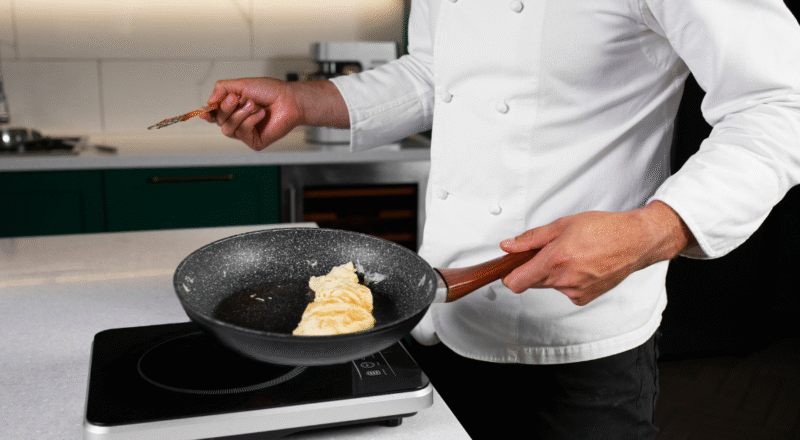In the ever-evolving world of cooking, the debate between cast iron and modern nonstick cookware continues to spark interest, especially when it comes to using these materials on induction cooktops. The choice between these two types of cookware can significantly impact your culinary experience. Understanding their differences and benefits is crucial for making an informed decision.

Introduction to Induction Cooking
Induction cooking is a modern method that utilizes electromagnetic fields to heat pots and pans directly. This technique is known for its efficiency, precision, and safety. However, not all cookware is compatible with induction cooktops, making it essential to choose the right material, such as cast iron or nonstick.
What is Cast Iron?
Cast iron cookware has been a staple in kitchens for centuries. Known for its durability and ability to retain heat, cast iron is favored by many chefs and home cooks. This material is particularly effective on induction cooktops due to its magnetic properties.
Benefits of Cast Iron
- Durability: Cast iron cookware can last a lifetime with proper care.
- Heat Retention: It retains heat well, ensuring even cooking.
- Non-Toxic: Cast iron is free from harmful chemicals found in some nonstick coatings.
Drawbacks of Cast Iron
- Weight: Cast iron is heavy, making it difficult to handle for some users.
- Maintenance: It requires regular seasoning to maintain its nonstick properties and prevent rust.
Understanding Modern Nonstick Cookware
Modern nonstick cookware is known for its ease of use and cleaning. It features a special coating that prevents food from sticking, making cooking and cleanup more straightforward.
Benefits of Nonstick Cookware
- Ease of Use: Food slides off easily, reducing the need for excessive oil.
- Lightweight: Nonstick pans are generally lighter than cast iron.
- Easy Maintenance: They require less upkeep compared to cast iron.
Drawbacks of Nonstick Cookware
- Durability Concerns: The nonstick coating can wear off over time.
- Potential Health Risks: Some coatings may release harmful chemicals when overheated.
Compatibility with Induction Cooktops
The compatibility of cookware with induction cooktops depends on its magnetic properties. Cast iron is naturally magnetic, making it an excellent choice for induction cooking. However, not all nonstick cookware is induction-compatible, so it’s essential to check compatibility before purchasing. Learn more about induction compatibility.
Performance on Induction Cooktops
Both cast iron and nonstick cookware perform well on induction cooktops, but their performance varies. Cast iron offers superior heat retention and even cooking, while nonstick pans provide convenience and ease of use.
Heat Distribution
Cast iron excels in heat distribution, offering consistent cooking results. However, it takes longer to heat up compared to nonstick pans. Nonstick cookware heats up quickly but may not distribute heat as evenly.
Cooking Versatility
Both types of cookware have their strengths in terms of cooking versatility. Cast iron is ideal for high-heat cooking methods like searing, while nonstick is perfect for delicate foods like eggs and pancakes.
Maintenance and Care
Caring for Cast Iron
Maintaining cast iron cookware involves regular seasoning to prevent rust and maintain its nonstick surface. After each use, it’s important to clean and dry the pan thoroughly. For more tips, visit cast iron seasoning after induction use.
Caring for Nonstick Cookware
Nonstick pans require careful handling to avoid damaging the coating. It’s advisable to use wooden or silicone utensils and avoid high heat to extend the life of the nonstick surface.
Environmental Impact
The production and disposal of cookware have environmental implications. Cast iron is recyclable and sustainable, while nonstick cookware may contribute to environmental issues due to its synthetic coatings.
Cost Considerations
When it comes to cost, cast iron is generally more expensive upfront but offers long-term savings due to its durability. Nonstick cookware is often more affordable but may need to be replaced more frequently.
Conclusion
The choice between cast iron and modern nonstick cookware for induction cooktops ultimately depends on individual preferences and cooking needs. Both types of cookware have their advantages and drawbacks. Understanding these factors can help you make an informed decision that enhances your culinary experience.

FAQs
1. Can all nonstick pans be used on induction cooktops?
Not all nonstick pans are suitable for induction cooktops. It’s essential to check the manufacturer’s specifications for compatibility.
2. How do I maintain the seasoning on my cast iron pan?
Regular seasoning is crucial for maintaining a cast iron pan. After each use, clean the pan, dry it thoroughly, and apply a thin layer of oil.
3. Are there health concerns with nonstick coatings?
Some nonstick coatings may release harmful chemicals when overheated. It’s essential to use nonstick pans within the recommended temperature range.
This article contains affiliate links. We may earn a commission at no extra cost to you.

